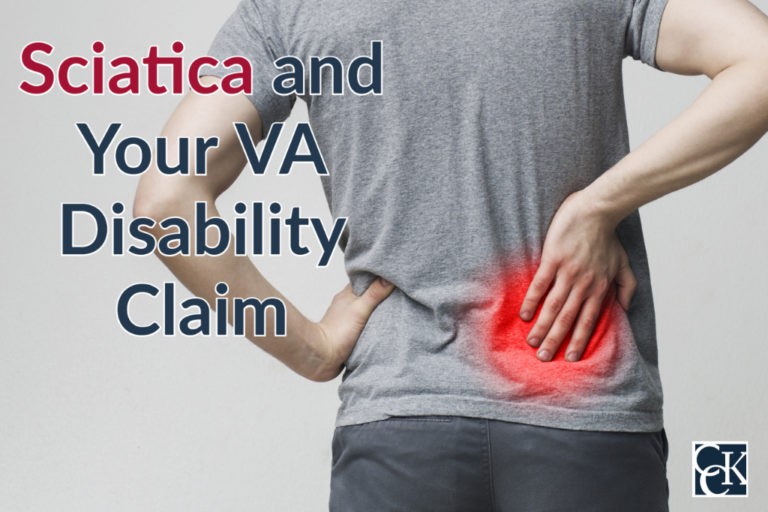Sciatica and Your VA Disability Claim

What is Sciatica?
Sciatica is a nerve condition in which pain radiates along the path of the sciatic nerve, traveling from the lower back down through the legs. As of 2020, roughly one million veterans are service-connected for paralysis of the sciatic nerve, making it the most commonly service-connected neurological condition.
Sciatica most often occurs when the sciatic nerve is compressed or pinched, typically by a herniated disk in the spine or an overgrowth of bone on the vertebrae.
Usually, sciatica affects only one side of the body. Common symptoms include:
- Numbness
- Tingling
- Burning sensation
- Muscle weakness

How Does VA Rate Sciatica?
Nerve issues, such as sciatica, are rated in three different categories based on the degree of severity of symptoms:
- Paralysis (the most severe category)
- Neuritis
- Neuralgia
Each of these three categories of nerve conditions also have sub-categories for mild, moderate, or severe symptoms, creating many different possible ratings for a condition that affects a nerve.
Technically, the term “sciatica” usually refers to neuralgia (i.e., sharp pain due to an irritated or damaged nerve) of the sciatic nerve. Therefore, neuralgia is generally the most common category that veterans fall into; however, it is possible that a veteran’s sciatica may present symptomatology consistent with a higher level of severity.
VA rates sciatica under 38 CFR § 4.124a, Schedule of ratings – neurological conditions and convulsive disorders, as follows:
Paralysis of the Sciatic Nerve – Diagnostic Code 8520
- 80% – complete paralysis in which all the muscles of the leg below the knee fail to work, causing serious difficulty in bending the knee
- 60% – incomplete but severe paralysis marked by muscular atrophy, poor blood circulation, and limited functionality of the affected body part
- 40% – incomplete but moderately severe paralysis
- 20% – incomplete but moderate paralysis
- 10% – incomplete but mild paralysis
Neuritis of the Sciatic Nerve – Diagnostic Code 8620
- 60% – severe neuritis marked by a loss of reflexes, loss of sensation, and muscle atrophy; seriously limited functionality of the affected body part
- 40% – moderately severe neuritis
- 20% – moderate neuritis
- 10% – mild neuritis
Neuralgia of the Sciatic Nerve – Diagnostic Code 8720
- 20% – moderate neuralgia involving tingling, numbness, and moderate to severe pain, along with interference with the affected limb’s functionality
- 10% – mild neuralgia causing tingling or mild pain, with only minor interference with the limb’s functionality
Importantly, there is no disability rating for severe neuralgia.
Issues with the VA Rating System for Sciatica
Sciatica ratings are usually based on whether the sciatica is mild, moderate, moderately severe, or severe. These terms, which the rating schedule uses, are highly subjective and vaguely defined. With the exception of severe incomplete paralysis, there are no specific symptoms listed in the rating criteria that veterans must have to receive a rating of mild, moderate, or moderately severe sciatica.
In 2019, the US Government Accountability Office (GAO) issued a report which said that the lack of specifics in the rating criteria is leading to unfair and arbitrary decision-making. While one veteran may have specific symptoms, and the Regional Office finds that they have moderate sciatica, another veteran could have those very same symptoms and be judged as having mild sciatica. As such, the report recommended VA create concreate criteria for determining whether neurological impairment related to the spine is mild, moderate, or severe.
VA does have some criteria in its Adjudication Procedures Manual, or the M21. However, the criteria listed here can also be subjective. This leaves room for many different interpretations and inconsistencies between the Regional Offices, Board of Veterans’ Affairs judges, and more.
Sciatica and TDIU
Sciatica can be incredibly difficult to live with and in severe cases can cause difficulty in walking and paralysis. Veterans with severe sciatica may require the assistance of canes, wheelchairs, or other assistive devices to walk.
As such, veterans living with sciatica may have trouble with many activities of daily living, including working certain jobs.
Total disability based on individual unemployability, or TDIU, is a monthly benefit available to veterans who are prevented from working due to their service-connected disability or disabilities. This benefit compensates veterans at the 100 percent level, even if their combined disability rating does not equal 100 percent. TDIU is essentially an alternative path to receiving maximum benefits.
Eligibility for TDIU
VA outlines TDIU regulations under 38 CFR § 4.16. TDIU can be awarded on a schedular or extraschedular basis.
- One service-connected condition rated at 60 percent or higher; or,
- Two or more service-connected conditions, one of which is rated at 40 percent or higher, with a combined rating of 70 percent or higher.
Veterans who do not meet the schedular requirements may still be considered for extraschedular TDIU under § 4.16(b).
Call Chisholm Chisholm & Kilpatrick For Help with Your Sciatica Benefits
It can be difficult to distinguish between the various categories and degrees of severity for sciatic nerve conditions. If your claim for benefits for sciatic nerve issues was denied, or you believe your current rating is lower than deserved, consult with an accredited veterans’ representative to discuss your right to appeal.
Chisholm Chisholm & Kilpatrick may be able to help you with the appeals process. Our veterans law practitioners have over 25 years of experience working with veterans. Call our office today for a free case evaluation.
About the Author
Share this Post
